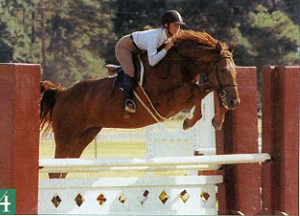George Morris critiques this rider from his column in Practical Horseman magazine.

This rider’s leg is beautiful, with heel down, ankle flexed, toe out, and calf on her horse–though she might try riding one hole shorter to help her stay with his mighty thrust. Here she’s jumped ahead of him a little bit, with her buttock too high and her upper body ducking over his neck; if she had an easier-to-reach foundation, she might not feel she had to jump to keep up with him. Nonetheless, she is a tight, effective rider.
Her back, head, and eyes are all in place, as is her crest release. But, once again, a rider this skilled should be using the automatic release, with a straight line from bit to elbow. To help my students get a feel for and learn to be comfortable with the automatic release, I have them practice dropping their hands down to the point of the should as the horse is in flight. Of course, this is an exaggeration of what the automatic release is, but it gets them moving and thinking and getting a feel of what it’s like to jump out of hand.
This horse has a very dramatic style, and he looks like a fun and capable ride. His knees are up by his eyeballs, and he is round as a ball. He might or might not have the scope for a really wide fence, but nonetheless he is an appealing individual.
Both horse and rider are clean, but their turnout is casual. The horse’s mane needs to be pulled and his hooves polished, that excess length of stirrup leather should be trimmed, and I always prefer to see a rider wear a jacket.
Reprinted from the August 2005 issue of Practical Horseman magazine. Is this photo of you? E-mail Practical.Horseman@EquiNetwork.com, and we’ll identify you.
To submit a photo of yourself to Jumping Clinic, send a 4×6 in. or larger horizontal PRINT to Jumping Clinic, Practical Horseman, 656 Quince Orchard Rd., Suite 600, Gaithersburg, MD 20878. If taken professionally, please include the photographer’s name and contact information. Photos will not be returned.










